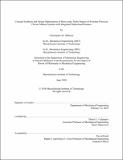Concept synthesis and design optimization of meso-scale, multi-degree-of-freedom precision flexure motion systems with integrated strain-based sensors
Author(s)
DiBiasio, Christopher M. (Christopher Michael)
DownloadFull printable version (7.192Mb)
Alternative title
Concept synthesis and design optimization of meso-scale, MDOF precision flexure motion systems with integrated strain-based sensors
Other Contributors
Massachusetts Institute of Technology. Dept. of Mechanical Engineering.
Advisor
Martin L. Culpepper.
Terms of use
Metadata
Show full item recordAbstract
The purpose of this research was to generate the knowledge required to 1) identify where and how to best place strain-based sensors in multi-degree-of-freedom (MDOF) flexure systems and 2) design a flexure system with optimal topology/size/shape for precision equipment and instrumentation. The success of many application areas (e.g. probe-based nanomanufacturing) hinges on the ability to design and realize low-cost, high-performance MDOF nanopositioners. The repeatability and accuracy of precision flexure-based instruments depends upon the performance of the flexure mechanism (e.g. bearings, actuators, and structural elements) and a metrology system (e.g. sensors). In meso-scale MDOF nanopositioners the sensing system must be integrated into the structure of the nanopositioner. The only viable candidate for small-scale, low-cost sensing is strain-based sensors; specifically piezoresistive sensors. Strain-based sensing introduces strong coupling and competition between the metrology and mechanical subsystems because these subsystems share a load path. Traditional tools for flexure system and compliant mechanism synthesis are not capable of simultaneously optimizing the mechanical and sensing subsystems. The building block synthesis approach developed in this work is the only tool capable of designing compliant mechanisms with integrated strain based sensing. Building block modeling allows for rapid synthesis and vetting of concepts. This approach also allows the designer to check concept feasibility, identify performance limits and tradeoffs, and obtain 1st order estimates of beam geometry. In short, this enables one to find an optimal design and set first order design parameters. The utility of the preceding is demonstrated via a case study. A meso-scale 6-DOF nanopositioner was designed via the building block synthesis approach. Polysilicon piezoresistors were surface micromachined onto a microfabricated silicon nanopositioner. The nanopositioner was actuated with moving magnet Lorentz force actuators. The final prototype costs less than $300 US and was found to have 10's of [mu]m range, nm-level resolution, and a 100 Hz 1st mode. The accuracy of the sensing system as determined by existing metrology equipment is better than 17% in-plane and better than 30% out-of-plane.
Description
Thesis (Ph. D.)--Massachusetts Institute of Technology, Dept. of Mechanical Engineering, 2010. This electronic version was submitted by the student author. The certified thesis is available in the Institute Archives and Special Collections. Cataloged from student-submitted PDF version of thesis. Includes bibliographical references (p. 171-178).
Date issued
2010Department
Massachusetts Institute of Technology. Department of Mechanical EngineeringPublisher
Massachusetts Institute of Technology
Keywords
Mechanical Engineering.